Lin Song
ATM-GAD: Adaptive Temporal Motif Graph Anomaly Detection for Financial Transaction Networks
Aug 28, 2025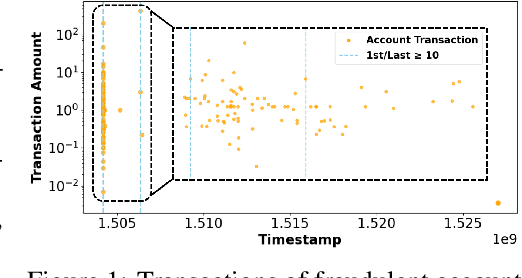

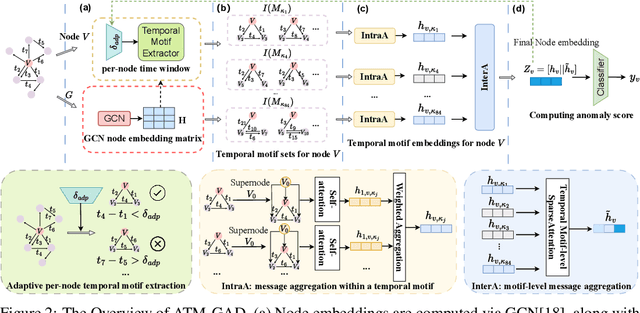

Abstract:Financial fraud detection is essential to safeguard billions of dollars, yet the intertwined entities and fast-changing transaction behaviors in modern financial systems routinely defeat conventional machine learning models. Recent graph-based detectors make headway by representing transactions as networks, but they still overlook two fraud hallmarks rooted in time: (1) temporal motifs--recurring, telltale subgraphs that reveal suspicious money flows as they unfold--and (2) account-specific intervals of anomalous activity, when fraud surfaces only in short bursts unique to each entity. To exploit both signals, we introduce ATM-GAD, an adaptive graph neural network that leverages temporal motifs for financial anomaly detection. A Temporal Motif Extractor condenses each account's transaction history into the most informative motifs, preserving both topology and temporal patterns. These motifs are then analyzed by dual-attention blocks: IntraA reasons over interactions within a single motif, while InterA aggregates evidence across motifs to expose multi-step fraud schemes. In parallel, a differentiable Adaptive Time-Window Learner tailors the observation window for every node, allowing the model to focus precisely on the most revealing time slices. Experiments on four real-world datasets show that ATM-GAD consistently outperforms seven strong anomaly-detection baselines, uncovering fraud patterns missed by earlier methods.
LoRA-Gen: Specializing Large Language Model via Online LoRA Generation
Jun 13, 2025Abstract:Recent advances have highlighted the benefits of scaling language models to enhance performance across a wide range of NLP tasks. However, these approaches still face limitations in effectiveness and efficiency when applied to domain-specific tasks, particularly for small edge-side models. We propose the LoRA-Gen framework, which utilizes a large cloud-side model to generate LoRA parameters for edge-side models based on task descriptions. By employing the reparameterization technique, we merge the LoRA parameters into the edge-side model to achieve flexible specialization. Our method facilitates knowledge transfer between models while significantly improving the inference efficiency of the specialized model by reducing the input context length. Without specialized training, LoRA-Gen outperforms conventional LoRA fine-tuning, which achieves competitive accuracy and a 2.1x speedup with TinyLLaMA-1.1B in reasoning tasks. Besides, our method delivers a compression ratio of 10.1x with Gemma-2B on intelligent agent tasks.
DetailFusion: A Dual-branch Framework with Detail Enhancement for Composed Image Retrieval
May 23, 2025Abstract:Composed Image Retrieval (CIR) aims to retrieve target images from a gallery based on a reference image and modification text as a combined query. Recent approaches focus on balancing global information from two modalities and encode the query into a unified feature for retrieval. However, due to insufficient attention to fine-grained details, these coarse fusion methods often struggle with handling subtle visual alterations or intricate textual instructions. In this work, we propose DetailFusion, a novel dual-branch framework that effectively coordinates information across global and detailed granularities, thereby enabling detail-enhanced CIR. Our approach leverages atomic detail variation priors derived from an image editing dataset, supplemented by a detail-oriented optimization strategy to develop a Detail-oriented Inference Branch. Furthermore, we design an Adaptive Feature Compositor that dynamically fuses global and detailed features based on fine-grained information of each unique multimodal query. Extensive experiments and ablation analyses not only demonstrate that our method achieves state-of-the-art performance on both CIRR and FashionIQ datasets but also validate the effectiveness and cross-domain adaptability of detail enhancement for CIR.
TensorAR: Refinement is All You Need in Autoregressive Image Generation
May 22, 2025Abstract:Autoregressive (AR) image generators offer a language-model-friendly approach to image generation by predicting discrete image tokens in a causal sequence. However, unlike diffusion models, AR models lack a mechanism to refine previous predictions, limiting their generation quality. In this paper, we introduce TensorAR, a new AR paradigm that reformulates image generation from next-token prediction to next-tensor prediction. By generating overlapping windows of image patches (tensors) in a sliding fashion, TensorAR enables iterative refinement of previously generated content. To prevent information leakage during training, we propose a discrete tensor noising scheme, which perturbs input tokens via codebook-indexed noise. TensorAR is implemented as a plug-and-play module compatible with existing AR models. Extensive experiments on LlamaGEN, Open-MAGVIT2, and RAR demonstrate that TensorAR significantly improves the generation performance of autoregressive models.
MindOmni: Unleashing Reasoning Generation in Vision Language Models with RGPO
May 19, 2025Abstract:Recent text-to-image systems face limitations in handling multimodal inputs and complex reasoning tasks. We introduce MindOmni, a unified multimodal large language model that addresses these challenges by incorporating reasoning generation through reinforcement learning. MindOmni leverages a three-phase training strategy: i) design of a unified vision language model with a decoder-only diffusion module, ii) supervised fine-tuning with Chain-of-Thought (CoT) instruction data, and iii) our proposed Reasoning Generation Policy Optimization (RGPO) algorithm, utilizing multimodal feedback to effectively guide policy updates. Experimental results demonstrate that MindOmni outperforms existing models, achieving impressive performance on both understanding and generation benchmarks, meanwhile showcasing advanced fine-grained reasoning generation capabilities, especially with mathematical reasoning instruction. All codes will be made public at \href{https://github.com/EasonXiao-888/MindOmni}{https://github.com/EasonXiao-888/MindOmni}.
YOLO-UniOW: Efficient Universal Open-World Object Detection
Dec 30, 2024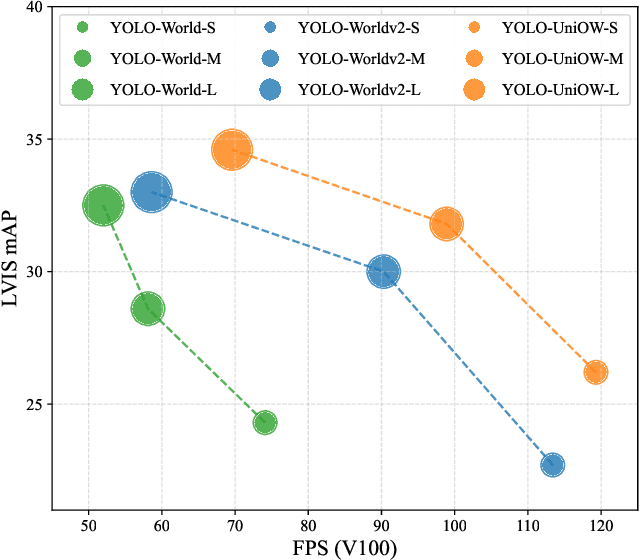
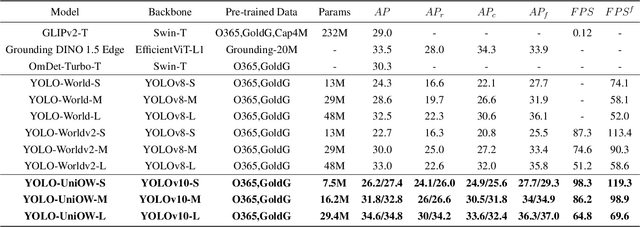

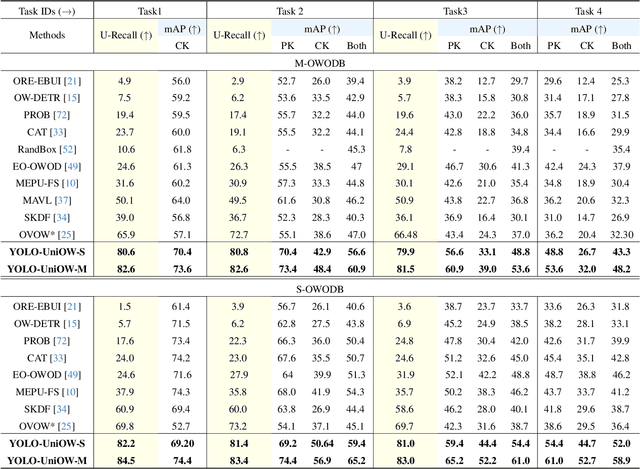
Abstract:Traditional object detection models are constrained by the limitations of closed-set datasets, detecting only categories encountered during training. While multimodal models have extended category recognition by aligning text and image modalities, they introduce significant inference overhead due to cross-modality fusion and still remain restricted by predefined vocabulary, leaving them ineffective at handling unknown objects in open-world scenarios. In this work, we introduce Universal Open-World Object Detection (Uni-OWD), a new paradigm that unifies open-vocabulary and open-world object detection tasks. To address the challenges of this setting, we propose YOLO-UniOW, a novel model that advances the boundaries of efficiency, versatility, and performance. YOLO-UniOW incorporates Adaptive Decision Learning to replace computationally expensive cross-modality fusion with lightweight alignment in the CLIP latent space, achieving efficient detection without compromising generalization. Additionally, we design a Wildcard Learning strategy that detects out-of-distribution objects as "unknown" while enabling dynamic vocabulary expansion without the need for incremental learning. This design empowers YOLO-UniOW to seamlessly adapt to new categories in open-world environments. Extensive experiments validate the superiority of YOLO-UniOW, achieving achieving 34.6 AP and 30.0 APr on LVIS with an inference speed of 69.6 FPS. The model also sets benchmarks on M-OWODB, S-OWODB, and nuScenes datasets, showcasing its unmatched performance in open-world object detection. Code and models are available at https://github.com/THU-MIG/YOLO-UniOW.
GrootVL: Tree Topology is All You Need in State Space Model
Jun 04, 2024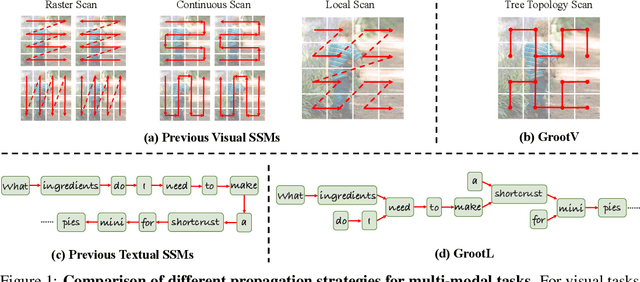
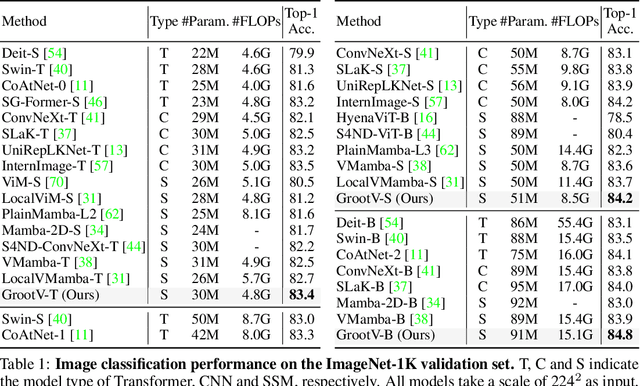
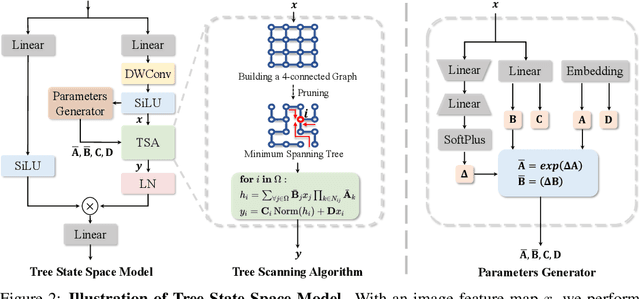
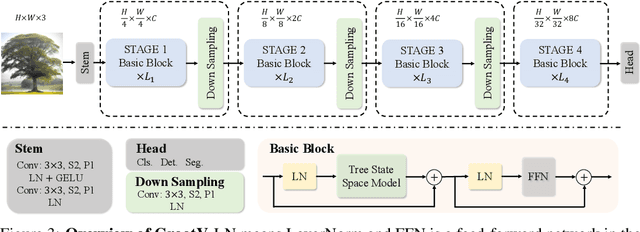
Abstract:The state space models, employing recursively propagated features, demonstrate strong representation capabilities comparable to Transformer models and superior efficiency. However, constrained by the inherent geometric constraints of sequences, it still falls short in modeling long-range dependencies. To address this issue, we propose the GrootVL network, which first dynamically generates a tree topology based on spatial relationships and input features. Then, feature propagation is performed based on this graph, thereby breaking the original sequence constraints to achieve stronger representation capabilities. Additionally, we introduce a linear complexity dynamic programming algorithm to enhance long-range interactions without increasing computational cost. GrootVL is a versatile multimodal framework that can be applied to both visual and textual tasks. Extensive experiments demonstrate that our method significantly outperforms existing structured state space models on image classification, object detection and segmentation. Besides, by fine-tuning large language models, our approach achieves consistent improvements in multiple textual tasks at minor training cost.
SEED-X: Multimodal Models with Unified Multi-granularity Comprehension and Generation
Apr 22, 2024Abstract:The rapid evolution of multimodal foundation model has demonstrated significant progresses in vision-language understanding and generation, e.g., our previous work SEED-LLaMA. However, there remains a gap between its capability and the real-world applicability, primarily due to the model's limited capacity to effectively respond to various user instructions and interact with diverse visual data. In this work, we focus on bridging this gap through integrating two enhanced features: (1) comprehending images of arbitrary sizes and ratios, and (2) enabling multi-granularity image generation. We present a unified and versatile foundation model, namely, SEED-X, which is able to model multi-granularity visual semantics for comprehension and generation tasks. Besides the competitive results on public benchmarks, SEED-X demonstrates its effectiveness in handling real-world applications across various domains after instruction tuning. We hope that our work will inspire future research into what can be achieved by versatile multimodal foundation models in real-world applications. The models, codes, and datasets will be released in https://github.com/AILab-CVC/SEED-X.
YOLO-World: Real-Time Open-Vocabulary Object Detection
Feb 02, 2024Abstract:The You Only Look Once (YOLO) series of detectors have established themselves as efficient and practical tools. However, their reliance on predefined and trained object categories limits their applicability in open scenarios. Addressing this limitation, we introduce YOLO-World, an innovative approach that enhances YOLO with open-vocabulary detection capabilities through vision-language modeling and pre-training on large-scale datasets. Specifically, we propose a new Re-parameterizable Vision-Language Path Aggregation Network (RepVL-PAN) and region-text contrastive loss to facilitate the interaction between visual and linguistic information. Our method excels in detecting a wide range of objects in a zero-shot manner with high efficiency. On the challenging LVIS dataset, YOLO-World achieves 35.4 AP with 52.0 FPS on V100, which outperforms many state-of-the-art methods in terms of both accuracy and speed. Furthermore, the fine-tuned YOLO-World achieves remarkable performance on several downstream tasks, including object detection and open-vocabulary instance segmentation.
Efficient and Interaction-Aware Trajectory Planning for Autonomous Vehicles with Particle Swarm Optimization
Feb 02, 2024



Abstract:This paper introduces a novel numerical approach to achieving smooth lane-change trajectories in autonomous driving scenarios. Our trajectory generation approach leverages particle swarm optimization (PSO) techniques, incorporating Neural Network (NN) predictions for trajectory refinement. The generation of smooth and dynamically feasible trajectories for the lane change maneuver is facilitated by combining polynomial curve fitting with particle propagation, which can account for vehicle dynamics. The proposed planning algorithm is capable of determining feasible trajectories with real-time computation capability. We conduct comparative analyses with two baseline methods for lane changing, involving analytic solutions and heuristic techniques in numerical simulations. The simulation results validate the efficacy and effectiveness of our proposed approach.
 Add to Chrome
Add to Chrome Add to Firefox
Add to Firefox Add to Edge
Add to Edge